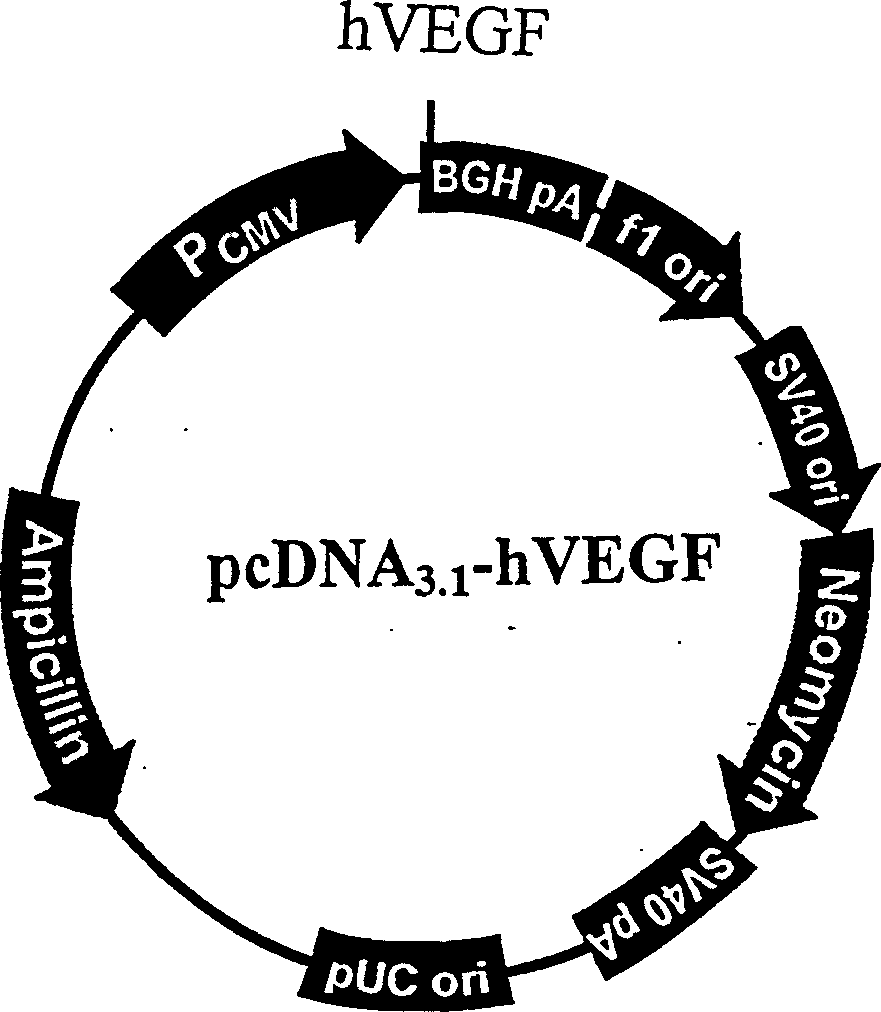Tissue vascularization promoting gene-chitosan nanometer granula complex
A technology of chitosan nanoparticles and complexes, applied in tissue culture, genetic engineering, plant gene improvement, etc., to achieve the effects of improving vascularization level, large specific surface area, and high expression
- Summary
- Abstract
- Description
- Claims
- Application Information
AI Technical Summary
Problems solved by technology
Method used
Image
Examples
Embodiment 1
[0010] Embodiment 1 Construction of recombinant pcDNA3.1-hVEGF plasmid
[0011] Plasmid pcDNA3.1 is a eukaryotic expression vector, which constructs a human cytomegalovirus promoter, which can express and regulate the inserted foreign gene. The plasmid itself carries the gene coding sequence of hVEGF, and can express and produce hVEGF under the action of its own expression control elements. There are 17 restriction restriction sites on the multiple cloning site of the plasmid. The BamHI and KpnI regions can be cut with restriction endonucleases, and then T4DNA ligase is used to connect the exogenous gene that has also been double-digested with BamHI and KpnI, so that it is placed under the control of the CMV promoter of human cytomegalovirus, In this way, the eukaryotic expression vector of the foreign gene is constructed (see accompanying drawing).
Embodiment 2
[0012] The structure of embodiment 2 gene-chitosan nanoparticle complex
[0013] It is prepared by coacervation method, and all operations are carried out under sterile conditions. First prepare a 0.03% chitosan (Sigma) solution, adjust it to pH 5.5 with 1N HCl, sterilize with a 0.22um filter membrane, and use a 75 μM sodium sulfate (analytical grade, Beijing Chemical Plant) solution (filtered with a 0.22um filter membrane) Sterilization) dissolve the pcDNA3.1-hVEGF recombinant plasmid to make its final concentration 200ug / ml. Take 200ul of 0.03% chitosan solution and 200ul of 75mM Na containing the recombinant plasmid pcDNA3.1-hVEGF 2 SO 4 The solutions were placed in 55°C water for 20 minutes at a constant temperature. Accurately absorb 200ul Na 2 SO 4 The solution was added to the chitosan solution, and quickly mixed on a vortex mixer for 30 seconds to prepare a suspension of the gene-chitosan nanoparticle complex.
Embodiment 3
[0014] Example 3 Construction of tissue engineered myocardium
[0015] Preparation of type I collagen scaffold: take a rat with a weight of about 250 grams, cut off the tail from the base of the tail, soak it in 75% alcohol for 30 minutes; cut the tail into 1.5cm small pieces under sterile conditions, remove the fur, and draw out Put the tail tendon on a plate, immerse in 150ml of acetic acid solution (0.01-0.25M), sterilize 10 pounds for 10 minutes under high pressure, put it in a refrigerator at 4°C, transfer it to a sterilized centrifuge tube after 48 hours, and centrifuge at 4000 rpm for 30 minutes. Draw the supernatant into vials and store in -20°C refrigerator for later use
[0016] Construction of tissue-engineered myocardium: Type I collagen was used as a scaffold to inoculate cardiomyocytes from suckling rats (1-2 days old). The preparation method of the cardiomyocytes is to take the myocardial tissue of suckling rats, chop and grind them into a uniform cell suspensi...
PUM
| Property | Measurement | Unit |
|---|---|---|
| particle size | aaaaa | aaaaa |
| particle diameter | aaaaa | aaaaa |
Abstract
Description
Claims
Application Information
 Login to View More
Login to View More - R&D
- Intellectual Property
- Life Sciences
- Materials
- Tech Scout
- Unparalleled Data Quality
- Higher Quality Content
- 60% Fewer Hallucinations
Browse by: Latest US Patents, China's latest patents, Technical Efficacy Thesaurus, Application Domain, Technology Topic, Popular Technical Reports.
© 2025 PatSnap. All rights reserved.Legal|Privacy policy|Modern Slavery Act Transparency Statement|Sitemap|About US| Contact US: help@patsnap.com

